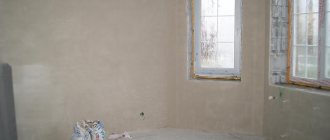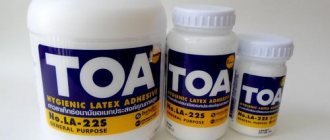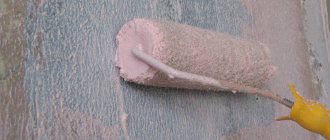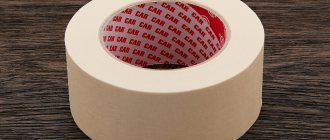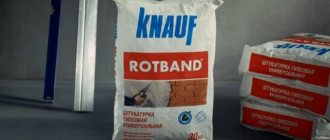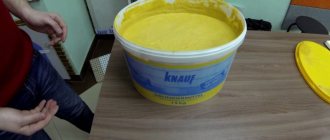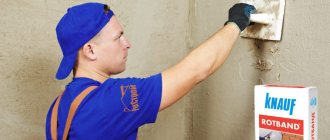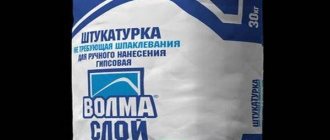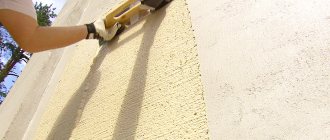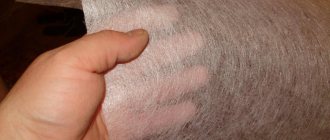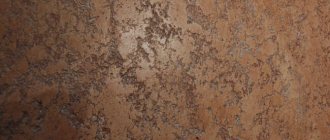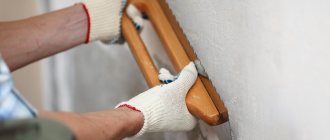Description of material
Latex putty is a popular type of mortar designed for leveling surfaces, filling cracks and small defects before final finishing and decoration. The material allows you to make walls, ceilings and other structures perfectly flat, smooth, suitable for absolutely all types of cladding. Putty will correct defects that still remain after rough leveling and can be very noticeable after painting and gluing thin wallpaper.
Latex-based finishing composition
The basis of latex putty is latex - a synthetic substance, an emulsion of dispersed polymer particles in an aqueous solution. In addition to the binder component, the construction mixture also includes other substances - hardening regulators, plasticizers, antiseptic additives and fungicides, elasticity, strength, adhesion enhancers, etc. Due to the presence of antiseptics and moisture resistance, the material is ideal for use in wet rooms, and the finished coating will be absolutely not susceptible to the appearance of fungus and mold.
Properties of elastic plaster
Today, flexible plasters are included in the product lines of many well-known companies; they are united by the main binding element - acrylic resin; natural and artificial fibers, quartz sand, and stone chips are used as fillers.
The material is released in ready-to-use form. In common parlance, another name for the material is often used - “rubber plaster”, which arose due to the ability of the coating to bend without cracks at a small radius and elongate up to 15% when stretched.
Coating properties:
- Environmentally friendly.
- Elasticity.
- Excellent adhesion to any substrate.
- Moisture resistance.
- Minimal water absorption.
- Resistant to temperatures ranging from minus 50 to plus 60 °C.
- Consumption depends on the evenness of the surface - from 0.3 to 2.7 kg/m2.
- Durability.
- Vapor permeability.
- UV resistance.
- Fire safety
- Possibility of cleaning and washing with neutral solutions.
- Possibility of tinting in RAL colors.
After application, we obtain a coating with a long service life that prevents the appearance of mold and mildew. Facade plaster can be used to repair old coatings. If desired, you can easily apply a relief pattern to the surface - bark, bark beetle, stone.
The conditions of use dictate some restrictions:
- Base temperature in the range +5 - +25°C.
- Humidity – no more than 65%.
- Protect from frost - loses properties when frozen.
- It does not like seams and joints, so it is advisable to finish a room or surface limited by some elements in one grip.
The unique properties of the material allow it to be used for both external and internal work, for finishing coatings in plaster (wet) insulation systems and for moisture-resistant coatings in rooms with damp and wet operating conditions (baths, swimming pools).
The composition is easy to apply, it does not flow, it is possible to use. If necessary, dilute with water (no more than 2%). The instrument is washed with water.
Pros and cons of putty
Latex putty is very popular among professionals and beginners, because it has a whole list of undeniable advantages:
- Elasticity. The hardened layer of putty will not develop cracks or peel off even when the building shrinks, or when it is located in a seismic zone. The material has a high ability to stretch, so it “moves” with the base and does not collapse, while it practically does not shrink on its own.
- Plasticity and ease of use. Latex putty is very easy to apply, spreads over the surface, and easily penetrates into the smallest cracks, as it has optimal viscosity. With its help you can even create three-dimensional elements - it is so easy to form. In addition, putty is often sold in finished form, and there is no need to dilute it before use - just stir well.
- Excellent adhesion. The putty immediately adheres to the base, holding it securely throughout its entire service life. It is equally firmly attached to all used building materials - concrete, brick, plasterboard, etc.
- Resistance to adverse effects. Most brands of latex putty are resistant to temperature changes, so they are ideal even for exterior finishing. The material is not afraid of precipitation and water, the influence of chemicals, and ultraviolet radiation. Thanks to its strength, it does not collapse or crumble when struck or scratched.
- Variety of options. The building mixture is presented in stores in different shades. If the desired color is not available, you can always tint it by choosing any suitable tone. More often, white putty is used, because it is ideal for painting, since it almost does not absorb paints and varnishes.
- Possibility of thin layer application. Latex putty can be rubbed into a layer less than 1 mm thick. This property is especially important when finishing drywall, because this material does not require leveling, and it is puttied only before the front finishing and to hide the joints and heads of fasteners.
There are few disadvantages to latex putty:
- Loss of properties when frozen. Most types of latex mixtures cannot be frozen, since they may undergo delamination and lose some of their properties. In many cases, after freezing and thawing, the material becomes completely unusable.
- High price. Compared to inexpensive gypsum plasters, latex putty is much more expensive. However, its consumption is so small that the final repair costs may be comparable, and the quality of the finished finish will be much higher.
Peculiarities
Latex putty is easy to apply. Proper preparation is a condition for successful repairs. To facilitate the work, you need to pay enough attention to the choice of manufacturer.
The material has recently appeared on the construction market, but is already popular.
The binder base of the mixture is latex, made from synthetic rubber. It allows you to obtain a material with unique properties, characterized by good strength and ductility.
Polymer additives are needed to improve the binder component, accelerate setting, and impart antiseptic and adhesive properties.
Types of latex putty
There are no fundamental differences between different brands of latex putty. Most mixtures are considered universal, that is, suitable for any situation. However, some manufacturers make notes on the putty packaging regarding its scope of application:
- for interior work;
- for outdoor work;
- for dry rooms;
- for wet rooms.
Depending on the form of release, there are ready-to-use formulations - they are sold in the form of a thick paste in plastic or metal cans and buckets. There are also dry mixtures in stores that need to be diluted with water before application.
How to divorce?
Ready-to-use latex mixtures are more convenient to use, as they do not require additional effort and time to prepare the solution. However, dry mixtures are cheaper and are no less popular. Dilute the powdered putty in ordinary water in proportions of one to one.
There is no need to prepare the solution at once from the entire amount of plaster in the package . It is necessary to pour a small amount of dry mixture into the putty container. Water is added to the material, stirring constantly.
After the mixture is well mixed with water until a homogeneous consistency is formed, you can begin finishing work. The prepared solution can be used within an hour, after which it will harden and become unusable.
Specifications
The exact characteristics of the putty may vary between specific products from different manufacturers. The average parameters of latex putties are as follows:
- approximate material consumption - 0.8-2.2 kg with a layer thickness of 1 mm;
- possible layer thickness - 0.5-3 mm;
- Shelf life: 12-24 months;
- Drying time for one layer at a temperature of +20 degrees and a humidity of 65% is 3 hours;
- interlayer drying period - 12 hours;
- Drying time before starting further finishing work is 24 hours.
Manufacturers
Before buying a composition, you need to study the properties and choose a specific manufacturer. You need to read the reviews.
Kinds
The Tex brand is a large manufacturer of building materials in Russia. The company sells high-quality materials at reasonable prices. Latex mixtures are available in two types:
“Profi” - for interior decoration, used for ceilings, walls, leveling before final cladding. The material is applied to plaster, concrete, drywall, fiberboard. The line comes in three shades – white, gray and cream. Container volume: 1.5 kg, 5 kg, 8 kg, 16 kg, 30 kg.
"Universal" - also for internal repairs. The solution is applied to the walls under wallpaper or paint; it dries very quickly. Under favorable conditions, this period takes only 4 hours. The thickness of the composition on the walls can reach up to 1 mm.
The good quality of the material has long been appreciated by consumers without experience working with putty.
The main advantages of the composition are as follows:
- economical consumption;
- availability;
- ease of application;
- strength of the created coating;
- absence of unpleasant, long-lasting odors;
- elastic, soft consistency of the solution.
Advantages
Some consumers note poor perception of the tinting mixture - this is a minus.
"Profilux"
Profilux is part of a large German concern. The brand produces and sells premium quality finishing materials.
Latex putty is available in finished form and is used to level surfaces. Pure white shades can be obtained. After hardening, a durable layer is formed on the surface that does not absorb moisture or mechanical stress.
Putty is even used for finishing. Masks defects, small seams, cracks. Drying time is 4-6 hours. Advantages of the composition:
- adhesion;
- ease of grinding;
- smoothness of the resulting surface;
- drying speed;
- ease of application.
"Lakra"
The brand complies well with the stated requirements for the material. The mixture has good adhesion, it does not shrink, and is easy to sand after drying.
The manufacturer included additives that protect walls from fungus. The mixture is used to level ceilings, walls, and mask seams.
The Lakra composition normally tolerates up to 3 cycles of freezing and defrosting. When defrosted at room temperature, the putty does not change its characteristics. It dries in 2 hours and can be painted after 24 hours.
Scope of application
Latex putty is suitable for working with various types of building substrates - plasterboard, concrete, brick, wood, OSB, plastered surfaces. It is not used only on metal bases, which is due to the low adhesion force.
Puttying drywall
The putty is suitable for finishing leveling walls, ceilings, arches, niches, recesses, and multi-level structures. It can also be used to process seams between sheets of drywall, repair not too deep defects, holes, chips, cracks and potholes, strengthen corners and slopes, and doorways. The material is suitable for use in any dry rooms, as well as in the bathroom, kitchen, and toilet. With its help, you can restore furniture and wooden objects, prepare products using the papier-mâché technique, and create various textures and textures. Many putties are suitable for exterior work for the purpose of leveling and creating a base for the following types of paintwork materials:
- water-dispersed;
- alkyd;
- oil;
- varnishes.
How does latex putty differ from acrylic putty?
The basis of latex putty is the synthetic polymer latex. The acrylic mixture, as you might guess, contains acrylic, a polymer based on acrylic acid. The difference between the two types of finishes is as follows:
- latex is more elastic, therefore less susceptible to cracking and shrinkage;
- acrylic is considered more vapor permeable than latex;
- the durability and wear resistance of the latex mixture is an order of magnitude higher than that of acrylic;
- the moisture resistance of latex is significant, it is ideal for working in wet rooms, unlike acrylic;
- among acrylic compounds there are those that can be used for rough leveling work, and latex putties are considered finishing;
- the cost of acrylic is lower than the price of latex;
- Latex putty dries faster than acrylic putty.
Details
Manufacturing companies
Before purchasing latex compounds, you should pay attention not only to the characteristics and composition of the mixture, but also to the manufacturer. To buy high-quality materials, you need to familiarize yourself in advance with manufacturers who have proven themselves in the finishing coatings market, as well as study product reviews.
This company is one of the largest Russian manufacturers of building materials. The company offers high quality products at reasonable prices, including latex putty compounds. Latex-based mixtures are produced in two types:
- "Universal".
- "Tex Pro".
Rules for using putty
First, you need to purchase a certain amount of putty mixture, for which you should measure the walls and calculate the volume of material (according to the consumption indicated by the manufacturer on the packaging). Professionals usually “fit” into the specified consumption figures, while beginners are advised to purchase an additional 15-20% of the mixture. Also for puttying you will need the following tools and consumables:
- deep penetration soil (especially important for porous bases);
- sickle tape for seams and joints;
- a set of spatulas - wide (35 cm) for rubbing putty, narrow (10 cm) for applying mass and processing hard-to-reach places, corner for finishing corners;
- polyurethane float or foam sponge for grinding the putty layer;
- fine sandpaper;
- roller and brush for applying primer.
Surface preparation
Before starting repair work, you need to carefully prepare the foundation. To do this, remove all dirt and dust from the walls or ceilings. Unstable layers of whitewash, paint, and old putty are removed; if necessary, individual areas or walls are plastered in advance. Smooth, glossy substrates are sanded using sandpaper to improve the quality of adhesion to the building mixture. The joints of the plasterboard sheets are sealed - serpyanka is glued on, covered with putty, dried and carefully sanded.
After cleaning, the surfaces are carefully inspected again for the presence of mold and mildew. The walls are completely or partially treated with specialized compounds with fungicides.
Next, they are covered with a deep penetration water-dispersed primer, which will bind dust residues, strengthen the base, and reduce the absorption of pores. Allow the primer to dry completely, and only then proceed to the main stage of work.
Cleaning the surface before puttying
Preparing the mixture
If the mixture is sold in dry form, it must be diluted with water strictly according to the instructions. Add the powdered mass to the water in small portions and mix using a construction mixer. After receiving the putty with the desired consistency, the process of applying it to the walls begins.
The finished compositions are brought into the room 2-3 hours before puttying, so that the mass has time to reach room temperature. If the putty is too thick, it can be diluted a little with water (no more than 5%). It is recommended to put portions of the composition in a small container if the store container has a significant volume. When the putty is not covered with a lid, it quickly hardens and becomes crusty.
Surface application
Scoop latex putty from the container with a small metal spatula, apply the mixture onto a wide tool and rub it over the surface in a thin layer (no more than 3 mm). If the room temperature is more than + 30 degrees, periodically spray a little water from a spray bottle onto the walls, otherwise the putty will set too quickly.
When several layers are required, the first is allowed to dry for 3 hours, then the second is applied. At the end of the work, the surface is sanded with a construction float or a damp foam sponge (if the coating requires ideal smoothness for painting).
The putty is applied using a wide spatula
Tips for choosing
Before buying any building material, it is always useful to find out the opinion of a specialist, to get useful advice from a master or a person who has used this or that putty solution. So, when choosing and using latex putty, you must:
- determine the type of surface on which it will be applied, since latex solution is not suitable for metal surfaces, and acrylic putty would be the ideal choice for wooden walls.
- Almost all types are used for interior work, but only a few types of mixtures are used for exterior work.
- This type of putty should only be purchased in heated stores.
Before use, the purchased solution must be placed for several hours in the room in which the finishing work will be carried out. This is done for temperature adaptation.
You need to make a small amount of solution to work. It is better to dilute the mixture little by little, but more often. This is due to the fact that the solution dries quickly. If a ready-made solution is used, it must be placed in small portions in another container so that debris does not get into the main container, which can subsequently scratch the walls.
- On walls that have been pre-treated with a primer, the putty applies better and more economically.
- If the putty solution is used for other purposes (for example, for papier-mâché), then it should be applied with a rubber spatula, and not with a standard one for walls or ceilings.
Precautionary measures
Latex putty does not harm the environment or human health, but when working with it you still need to follow certain safety measures. When distributing the mass and especially when grinding it, you should ensure a flow of clean air into the room and organize high-quality ventilation. You must wear protective clothing when working, and wear a respirator when grinding. If the material comes into contact with the skin, rinse the area with water to avoid allergic reactions.
Review of the best brands of latex putty
The stores offer a decent selection of latex putties, but professionals prefer to purchase only proven brands.
"Tex Pro"
This material is a leader among the offerings of construction stores. The putty is produced by one of the most famous companies in this industry - Tex, which produces a variety of finishing mixtures at affordable prices. Latex-based putty “Tex Profi” is used for interior finishing of walls, ceilings, and other structures for the purpose of leveling before coating with finishing materials. It is produced in containers of 1.5-30 kg.
The composition ideally fits on concrete, plasterboard, plaster, fiberboard, is produced in gray and white colors, has minimal consumption (1 kilogram of mass is enough for 0.6-2 square meters of wall). The putty forms a durable surface, is easy to apply and sand, can be applied in a layer with a thickness of 1 mm, and dries in 4 hours.
"Lakra"
Lakra latex putty is intended for interior work. It is characterized by high adhesion to walls and ceilings made of concrete, asbestos, plaster, and is suitable for sealing joints of gypsum board sheets using reinforcement. The material is also used for grouting cracks, preparing bases for painting and wallpapering. The features of the putty are:
- ready-to-use form;
- no shrinkage over time;
- excellent sanding;
- contains fungicides;
- stored for 18 months at +5...+35 degrees;
- fire-, explosion-proof;
- environmentally friendly;
- has no smell.
"Knauf"
Finishing putty from Knauf is ideal for professional use, as it has a more complex application. It is important to apply it in the thinnest, even layer, so before work you will have to practice on a rough surface. The characteristics of the composition are as follows:
- paste form;
- increased whiteness;
- excellent adhesion to building substrates;
- crack resistance;
- high plasticity;
- quick filling of defects;
- fine particle size;
- possibility of machine application;
- high smoothness;
- no white marks when touching the surface.
Knauf Rotband Pasta Pro
"Vetonit"
This is an inexpensive but very high-quality material intended for finishing leveling surfaces in dry rooms. After applying the putty, you can paint, wallpaper, tile, or apply decorative plaster. The putty is white, super-plastic, and applied in a layer 1-3 mm thick. It is economical in consumption, easy to sand, and the layers fit perfectly on top of each other. After 12 hours, the coating will be completely ready for further finishing.
"Shitrock"
This material is produced in the USA and contains latex, vinyl fibers, as well as modern plasticizers and fillers. It is easy to use, easy to apply and level, and sands effortlessly. The putty is intended for finishing concrete, brick, painted, plastered and plasterboard walls. It is also suitable for sealing cracks in plaster and seams between gypsum plasterboard sheets, since it has maximum resistance to cracking.
"Optimist"
Universal latex putty for interior work of the Optimist brand is used for sealing cracks and leveling various surfaces. It is suitable for processing wood, hardboard, concrete, brick, plasterboard, plaster. The main properties and technical features of the material are as follows:
- high adhesion to substrates;
- quick and easy sanding;
- possibility of coloring;
- plastic;
- environmental friendliness;
- consumption 0.8-1 kg/sq. m;
- drying time - 24 hours.
"Hermes"
The material is widely used for finishing preparation of walls and ceilings made of gypsum plasterboard, for finishing concrete, plastered and other organic substrates. Hermes putty is suitable for rooms with normal and high humidity, including basements. The thickness of the working layer is 0.5-1.7 mm, but it can be increased by sequential application of subsequent layers with complete intermediate drying.
Moisture-resistant composition Germes
Wood putty Colorika Aqua
The environmentally friendly material of the Colorika Aqua brand is also sold in finished form and does not require mixing of components. The putty is used for woodwork, but is suitable for application to other substrates. It is odorless, has low shrinkage, is easy to sand, and dries quickly. The material is ideal for filling cracks, cavities, pores, and correcting various defects in walls and ceilings.
Latex wood putty Colorika Aqua
Latex putty is a modern, high-quality, yet quite economical material for finishing walls. It will come in handy if you plan to do the finishing yourself and get an excellent result. The effectiveness of latex mixtures is confirmed by professionals: the evenness, smoothness and durability of the finished coating is beyond doubt.
Advantages of latex-based putty
- Increased strength and hardness of the coating;
- Possibility of applying a light and super-thin layer (less than 1 mm);
- Convenience and ease of use;
- High elasticity and penetrating ability;
- Excellent adhesive properties;
- Good wear resistance and durability of the finished coating;
- Resistant to UV radiation and weathering;
- Withstands temperature changes;
- Not subject to shrinkage (does not bubble or crack after hardening);
- Low consumption;
- Available in various colors;
- Vapor-tight, does not absorb moisture;
- Eco-friendly;
- Possibility of creating decorative reliefs on the surface.
